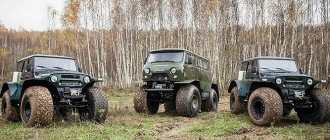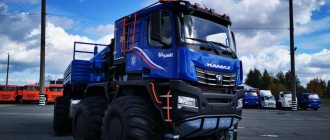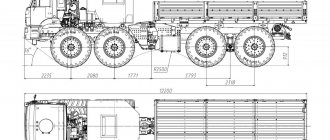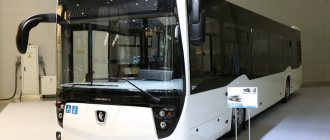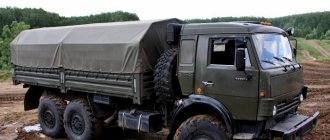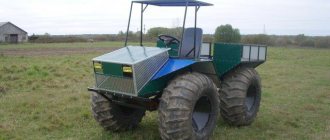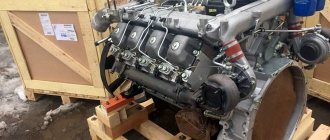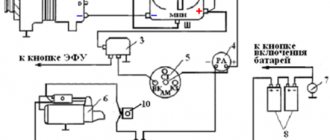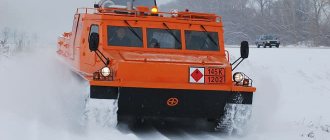Author: Dina Ga
31 October 2022 10:47
Community: Autoworld
Tags: automobile industry cars all-terrain vehicles Kamaz Kamaz-4310 all-wheel drive
1566
14
It has many advantages: reliable (failure-free operation in any climatic conditions), unpretentious (if it suddenly broke down, which happened very rarely, it was easily repaired), “all-terrain capability” is not just words, the car felt great both on the road and off-road, in hot deserts, and in extreme snowy terrain - for its time it was one of the most advanced four-wheel drive trucks.
0
See all photos in the gallery
0
Let us note the fact that it was on the modified KAMAZ-4310 that the KAMAZ-master athletes took second place in the Dakar for the first time in history. In addition to the KAMAZ-S4310 sports car, this car gave birth to many more well-proven cars of the family. But today we will tell the story of his name - the KAMAZ 4310.
×
0
This is an all-wheel drive vehicle with three independent axles. Began production at KAMAZ in 1981, serial production of the vehicle ended in 1989. During this time, the auto giant produced 61,777 KAMAZ-4310 trucks. After this, other cars of the family were produced, which we will tell you about later.
"KAMAZ Arctic": this Russian all-terrain vehicle will surprise anyone
The Kama Automobile Plant is actively expanding the scope of its presence in the transport sector of Russia. A recent example is the creation of the KAMAZ Arctic family of all-terrain heavy-duty vehicles. Chelny automakers were prompted to take up a completely new topic for themselves by participating in a complex project to create a high-tech production of environmentally friendly all-terrain vehicles on low-pressure tires for the development of the Arctic zones of Russia, as well as the federal targeted research and development program in priority areas of the scientific and technological complex.
Valery Vasiliev
The Arctic family is required to move equally successfully on public roads and impassable terrain (virgin snow, tundra, loose sand and other weak-bearing soils) without causing damage to vegetation and soil. In addition, all-terrain vehicles will become the basis for the creation of remotely controlled, robotic vehicles.
FOR STORMING THE NORTHERN LATITUDES
If you look at the Russian off-road equipment market, it is easy to find that there are mainly vehicles suitable for use in the middle zone and not at all suitable for use in extreme conditions. There is a particularly significant shortage of heavy models with a carrying capacity of 10 tons and above, including those for work in the Arctic zone. They placed their bets on heavy-duty snow and swamp-going vehicles capable of operating at temperatures down to –60°C.
The “folding” frame guarantees the maneuverability of the all-terrain vehicle.
The alliance, which was headed by KAMAZ, included the Moscow Polytechnic, Scientific and Technical Center "Industrial Design", MSTU named after. Bauman and . At the helm of the project was the chief designer for innovative products of the KAMAZ Scientific and Technical Center, Sergei Nazarenko. The core of the project will be vehicles with 6x6 and 8x8 wheel arrangements. They will be used primarily for transporting goods, towing trailers, installing special equipment and engineering installations for national economic purposes. The driving characteristics of all-terrain vehicles allow them to act as vehicles that will pave the way for a convoy of general transport vehicles.
KAMAZ Arctic was built using a considerable number of serial units.
A cable winch was installed at the rear.
It must be said that KAMAZ and its partners have never worked with machines of this type before. Therefore, they had to solve a number of new complex problems. According to the plan, the creation of a single family of three- and four-axle all-terrain vehicles based on units of serial KAMAZ vehicles, which are supplemented with original systems and devices that provide ultra-high cross-country ability, reduces production costs and significantly facilitates maintenance and repair, including at a distance from repair bases.
"FOOTWEAR" TO ORDER
The layout and many engineering solutions of all-terrain vehicles were largely determined by the choice of propulsors. Having studied domestic and foreign experience, the developers settled on wheels of the maximum possible size for this case. MSTU took up the solution to this issue. Bauman. Since wheels for off-road work are subject to very contradictory requirements - minimal pressure on the underlying surface, high grip properties and the ability to drive an all-terrain vehicle on public roads - the designers took the path of creating two types of propulsion devices: “Overall” and “Overall”.
The engine is protected from below by a special panel.
The “Gabarit” version provides low pressure on the ground and the ability to drive the all-terrain vehicle on public roads. Since the outside width of the truck must be kept to 2.55 m, there is not much space left to accommodate the tires. In this case, it is necessary that the supporting surface of the movers be as large as possible. In accordance with these conditions, the outer diameter of the tire was determined to be 1960 mm, and the width - 716 mm. The maximum tire load is 5.3 tons. Maximum speed is 60 km/h.
The highlight of the machine is the articulation unit.
The “Oversized” option has a smaller diameter of the wide-profile tire - 1650 mm, but the width is increased to 1050 mm. Due to the reduced specific pressure, cross-country ability on soft soils is improved, but you cannot drive on public roads. Speed is limited to 50 km/h. After installing these wheels, fender flares are mounted on the vehicle to protect the cab from dirt.
Solid front axle with leaf spring suspension.
Without waiting until they mastered the production of new tires, SUVs were “shod” in the closest production analogues. The most suitable within the “Dimensions” option turned out to be the radial tire Nortec TA-01 710/70R38 (outer diameter - 1920 mm, profile width - 710 mm), used on agricultural tractors. For the “Oversized” version, the best model was 66x43.00R25 SB-1, used on the Kirovets K-700 and K-701 tractors. Its outer diameter is 1650 mm, profile width is 1052 mm. Serial tires are not designed to operate at very low temperatures, but this is justified to test the driving performance of an experimental vehicle.
"BREAKING" BUT DON'T GIVE UP
As expected, the first-born was the KAMAZ-6345‑3101 model with a 6x6 wheel arrangement and a carrying capacity of 13 tons. The impressive dimensions of the wheels forced the creators to implement an articulated design. To do this, the spar frame was cut into two parts, connecting them together with a mechanism that ensured their mutual rotation in the horizontal plane at an angle of ±45°. The articulation unit consists of two box-shaped structures connected by a pair of ball joints. The sections are moved around the vertical axis by hydraulic cylinders located inside the frame. This made it possible to protect the hydraulic cylinder rods from dirt and mechanical damage, use a standard frame cross member as a back stop, and unify the mounting points for hydraulic cylinders for three- and four-axle models. The “breakable” frame provided the 11 m long three-axle with a minimum turning radius (along the outer front wheel) of 12 or 14 m, depending on the type of tires installed.
The unique flavor of the all-terrain vehicle is given by the re-faced cabin, the original bumper, and a lot of handrails and stairs.
The KAMAZ-6345‑3101 with a total weight of 30 tons is powered by the KAMAZ-740.37‑400 diesel engine (V8, 11.76 l) with a power of 400 hp. With. The power chain includes a single-disc diaphragm clutch MFZ 430 with a remote pneumohydraulic drive, a mechanical 16-speed gearbox ZF 16S 1822, a two-stage transfer case KAMAZ-633-1800020, equipped with a locking center differential, and drive axles with wheels borrowed from KAMAZ-6520 gearboxes. Moreover, 27.5% of the engine power is supplied to the front wheels, and 72.5% to the rear wheels.
Anti-roll bars are installed on all axles.
The front suspension is spring. It uses elastic elements from the rear suspension of KAMAZ-5460, while shock absorbers, anti-roll bar with struts, buffers and other parts came from KAMAZ-65225. The rear suspension is a pair of rigid balancers, which are connected by drive axles using four elastic supports. The chassis uses torque rods and anti-roll bars.
3. The brutality of the KAMAZ-6345‑3101 design is difficult to deny.
The ground clearance of an all-terrain vehicle with “Gabarit” tires reaches 677 mm, and the front approach angle is 27°. The fuel supply is stored in two tanks with a volume of 350 liters each. A cargo platform about 5 m long with folding sides and a traction device were placed on the rear section of the all-terrain vehicle. At the same time, the loading height is 2.2 m. A hydraulic winch with a pulling force of 22.5 tons is attached under the body at the rear of the frame.
AT THE SERVICE OF THE CREW
Employees of the Scientific and Technical Center “Industrial Design” worked on the external architecture and interior of KAMAZ Arctic, and their Chelny partners produced a residential module, power and frame elements, and composite parts of the lower belt. During the search work, it was decided that the main visual elements would be the “ennobled” KAMAZ cabin and a separate utility compartment. The cabin was additionally insulated, equipped with handrails and side ladders, and flashing lights were installed on top. The massive bumper fits well into the overall composition, in which the main headlights, located in two tiers in height, are hidden under the protective grilles. The household compartment is a frame covered with fiberglass panels, the internal cavities between which are filled with heat-insulating material. The volume of living space and internal equipment allow three crew members to travel, who in case of an emergency can expect outside help for at least three days. For relaxation, there are wide and soft sleeping shelves, located in two tiers at the front wall and one in the cabin. Nearby there is a folding table and a wardrobe. Under the bottom shelf there is a spacious compartment for luggage and a refrigerator. On the opposite wall there is another seat and a kitchen unit, which includes a hob, microwave, sink, hood, food storage drawers, and a 200-liter water tank. The autonomous heater maintains the desired microclimate at ambient temperatures down to –50° C. In summer, air conditioning is available. The standard package includes a bathroom. The household compartment can only be accessed from the outside, using a ladder, which, in the stowed position, slides under its bottom. For the convenience of the crew there are platforms, additional steps, handrails and ladders. The module can be dismantled at any time, making it a separate compact dwelling with all amenities.
Standard equipment includes a kitchen block and a bathroom.
The crew has comfortable sleeping places and a folding table.
KAMAZ-6345‑3101 passed all laboratory tests, after which the vehicle completed a series of test runs in Naberezhnye Chelny. The all-terrain vehicle awaits the cold regions of the country, where it will undergo serious testing.
Work continues on the four-axle model, which is planned to be built at the end of this year. The vehicle's carrying capacity reaches 16 tons, the total weight is 40 tons. The increased cargo capacity makes it possible to accommodate a larger residential module and more impressive superstructures. The SUV will be equipped with a KAMAZ-910.12 diesel engine (450 hp) and a 6-speed Allison automatic transmission. The service life of the engine, the production of which Liebherr is helping to develop, will be 1.5 million km.
The editors recommend:
Why do piston rings stick and how to prevent it?
A traffic police officer searched my car: did he have the right to do so?
Russians may be left without foreign cars: Western automakers have stopped supplying cars to our country
A ship that was transporting cars to Russia was detained in France
Half of the car factories in Russia have closed
News Media2
Discussion Cancel
Modifications
A catalog of KamAZ-4310 modifications will be presented here. The very first modification was so successful that it began to be produced with minor changes from 1981 until the 1990s. Depending on the modification, the cabin came with a hydraulic forward tilt system, and a berth could be installed as a separate option.
Already 8 years later, in 1989, the plant began to produce additional equipment, for example, KamAZ-43101 was sent to help agriculture, equipped with benches that could be removed, which as a result made it possible to transport up to 30 people. In addition to the fact that you can transport passengers, this configuration allows you to use a “2PN-4M” trailer. The standard equipment has a winch and an extra bed.
The same year allowed the release of KamAZ 43106, which differed from the previous version in its reduced dead weight, however, it could carry 1 ton more (7 tons). It was possible to attach a trailer to it, which was often used in the open plan "GKB-8350", or its variation with a folding awning.
The KamAZ 4310 model timber truck could work in hard-to-reach places and required a trailer. The car copes with its tasks perfectly, despite frequent overloads.
The beginning of the 90s showed everyone a semi-handicraft armored version of the Typhoon-1. This modification has a booth to transport soldiers, and powerful frontal armor plates that can protect the cabin. Good technical characteristics made it possible to take 4310 as the basis for such a modification.
Some may mistakenly believe that this model is precisely the first version of the new anti-terrorist armored personnel carrier "Typhoon", which was made according to orders from the Ministry of Defense of the Russian Federation. However, everything is not like that. The debut “Typhoons” was shown only in 2011. This is the fruit of the common developments of the engineering staff of the Ural and KamAZ automobile companies. They were not built on the 4310 base.
Also, very interestingly, the company released a sports version of the car, which was called C4310. The purpose of production was to participate in rally raids. When they built their debut sports car, specialists borrowed the production version of the KamAZ 4310.
Therefore, the new vehicle was assigned the KamAZ S4310 index. If we talk about the technical stuffing, the base power unit (210 horses) was boosted to 290 horsepower, thanks to the introduction of turbochargers and increased fuel supply.
On top of that, the racing car's engine featured variable profile pistons, torsional vibration dampers, an improved lubrication system, and the cooling system had a viscous coupling and a fan with increased efficiency. The model's chassis had rigid springs and special shock absorbers.
In accordance with FIA standards, roll bars were installed on the truck. Also, the C4310 brand differed in appearance from the base one in that they used a brand new awning, which was painted yellow, while ordinary cars came with a green awning. September 1988 was the truck's first month on the rally road.
The crews of the KamAZ-Master team took part in the Jelcz European Rally, which took place within the city of Wroclaw in Poland. The car was able to take 2nd and 4th place in the individual competition and 1st in the team competition. A few years later, in 1991, the sports truck took 2nd place at the famous Paris-Dakar rally marathon.
After this, the manufacturer carried out the following updates, so already in 1991 KamAZ had a brand new eight-cylinder power unit (KAMAZ 7482), which produced 430 horsepower. Later, it was this engine that became standard for the serial KamAZ.
Main modifications
| KAMAZ-4310 | Basic version. It was distinguished by a shortened platform with an awning, a tailgate and folding seats (for 30 people) along the sides. Produced in 1983-1990. |
| KAMAZ-43101 (experienced) | Transport option. The cargo platform differed from the KAMAZ-5320 by three folding sides. |
| KAMAZ-43101 | Modernized version of KamAZ-4310. It featured a KamAZ-740.10-20 engine with a power of 220 hp. Load capacity increased to 6 tons. Produced in 1989-2000. |
| KAMAZ-431010 | Sports version. Made for the Paris-Dakar rally. In 1992 he participated in the Paris-Moscow-Beijing marathon. |
| KAMAZ-43102 (experienced) | Option KAMAZ-43101 with a sleeper cab. |
| KAMAZ-43103 (experienced) | Another version of KAMAZ-4310 with a sleeper cab. |
| KAMAZ-43105 | Civil transport. It was distinguished by the absence of a winch and a tire pressure regulation system. |
| KAMAZ-43106 | Civil transport. It featured a KamAZ-740.10-20 engine. Produced in 1989-2000. |
| KAMAZ-43114 | Modernized army version. It features a turbocharged diesel engine KamAZ-7403.10 with a power of 260 hp. With. Produced since 1996. |
| KAMAZ-43115 | Modernized, civil, transport. It features a KamAZ-7403.10 engine. Produced since 1998. |
| KAMAZ-43118 | Transport with an enlarged loading platform. It features a KamAZ-7403.10 engine. Produced since 1996. |
| KAMAZ-4410 | Truck tractor based on 4310. Designed for towing special semi-trailers with a total weight of up to 15 tons. |
